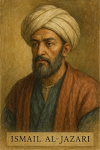Abu’l-Wafa (940–998 CE): The Genius of Trigonometry and Astronomy
Introduction
Abu’l-Wafa al-Buzjani was a pioneering Persian mathematician and astronomer of the Islamic Golden Age. His contributions to trigonometry, astronomy, and mathematical theory remain significant even today. He introduced new mathematical functions, improved existing methods, and contributed to the development of precise astronomical calculations. His legacy extends beyond the medieval Islamic world and continues to influence modern science.
Early Life and Background
Birth and Education
Abu’l-Wafa was born in 940 CE in Buzjan, a town in present-day Iran. He received his early education in mathematics and astronomy from renowned scholars of the time. Recognizing his talent, his mentors encouraged him to pursue advanced studies. As a young mathematician, he moved to Baghdad, the intellectual hub of the Islamic world, where he worked under the patronage of the Buyid dynasty.
Influence of Baghdad’s Intellectual Environment
Baghdad, during the 10th century, was a center of knowledge, home to the House of Wisdom (Bayt al-Hikma). Scholars from diverse backgrounds exchanged ideas, translating Greek, Indian, and Persian texts into Arabic. This atmosphere provided Abu’l-Wafa with access to the works of ancient mathematicians such as Ptolemy, Euclid, and Diophantus. His exposure to these texts allowed him to refine and expand mathematical theories, particularly in trigonometry.
Contributions to Mathematics
Advancements in Trigonometry
Abu’l-Wafa is best known for his groundbreaking work in trigonometry. He made substantial contributions, including:
Tangent Function Development: He was the first mathematician to define and use the tangent function systematically, which played a crucial role in later trigonometric studies.
Sine and Cosine Table Refinements: He computed accurate sine and cosine tables with increased precision, improving upon the work of earlier scholars.
New Trigonometric Identities: He derived several trigonometric identities, some of which are still in use today.
One of his most famous identities is:
This formula remains a fundamental part of modern trigonometry.
Practical Applications of Trigonometry
Abu’l-Wafa’s work was not limited to theoretical mathematics. His research in trigonometry had practical applications in engineering, architecture, and astronomy. His calculations were used to measure distances and angles for constructing buildings, determining celestial positions, and solving navigational problems.
Contributions to Astronomy
Refinement of Astronomical Tables
As an astronomer, Abu’l-Wafa contributed significantly to the accuracy of astronomical tables, which were essential for timekeeping, navigation, and astrology in the medieval Islamic world. He compiled a set of refined tables that improved upon those of Ptolemy and earlier Islamic scholars.
Observations of the Moon
One of Abu’l-Wafa’s most remarkable achievements was his detailed observation of the Moon. He discovered a lunar irregularity known as the "variation," an effect where the Moon's position deviates slightly from what was predicted by Ptolemaic models. This discovery predated similar findings by European astronomers like Tycho Brahe by nearly six centuries.
Contributions to Spherical Astronomy
Abu’l-Wafa also worked extensively on spherical astronomy, a branch of astronomy dealing with the positions of celestial objects. He introduced several mathematical methods to solve problems related to the movement of stars and planets, which helped in improving the Islamic calendar and religious observances.
Influence on Later Mathematicians and Astronomers
Impact on Islamic and European Scholars
Abu’l-Wafa’s work influenced both Islamic and European scholars. His texts were translated into Latin during the Renaissance, helping to shape the development of trigonometry and astronomy in Europe. Mathematicians such as Regiomontanus and Copernicus benefited from his discoveries.
Legacy in the Modern World
His contributions to mathematics and astronomy laid the groundwork for future advancements. Trigonometric functions, lunar observations, and astronomical calculations developed by Abu’l-Wafa are still relevant in modern scientific research. Today, his name is honored through lunar craters and various scholarly references in mathematical history.
Works and Writings
Almagest Commentary
One of his most important works was his commentary on Ptolemy’s Almagest, in which he corrected errors, expanded trigonometric calculations, and introduced new mathematical functions. This commentary provided future scholars with improved methods for astronomical calculations.
Book on What Is Necessary from Geometric Construction for a Scribe and Geometer
This book was a practical manual detailing geometric constructions needed for engineers and artisans. It served as an essential reference for architects and surveyors in the medieval Islamic world.
Other Lost Works
Several of Abu’l-Wafa’s works have been lost over time, but references to them exist in the writings of later scholars. His influence can still be seen in surviving medieval Islamic mathematical and astronomical texts.
Conclusion
Abu’l-Wafa al-Buzjani was a visionary mathematician and astronomer whose contributions transformed the fields of trigonometry and astronomy. His innovations in mathematical functions, precise calculations, and celestial observations remain relevant even today. By refining earlier theories and introducing new methodologies, he helped bridge the gap between ancient and modern science. His work continues to inspire mathematicians, astronomers, and historians, cementing his legacy as one of the greatest scholars of the Islamic Golden Age.
References
1. Berggren, J. L. Mathematics in Medieval Islam. Cambridge University Press, 2016.
2. Saliba, George. A History of Arabic Astronomy: Planetary Theories During the Golden Age of Islam. New York University Press, 1994.
3. Kennedy, E. S. The Numerical Solution of Equations in Islam. The American University of Beirut, 1960.
4. King, David A. Islamic Mathematical Astronomy. Routledge, 2015.
This article presents a detailed yet concise account of Abu’l-Wafa’s life, achievements, and legacy, highlighting his immense contribution to the fields of mathematics and astronomy.






0 Comments